Any household plot requires the owner of large works, attention and knowledge of the basic rules and peculiarities of growing various plants. After all, to make a beautiful landscape, it is important to clearly understand all the agronomic and decorative properties of different cultures. It is necessary to ensure optimal growing conditions, only so the plant will delight gardeners with its bright and lush flowering.
Filipendula or a labaznik is a perennial plant, which is distinguished by unpretentious care and can grow perfectly in almost any terrain. If your site has an artificial pond or a reservoir, putting this plant next to this, you will make a bright and unusual garden composition. In the spring during flowering, snow-white or pink foam colors are harmoniously combined with water stroke. In this article, we consider the features and description of the plant of Filiptendula, we note the characteristics of popular species and varieties of this culture. We give important rules and nuances of landing and care for Filipendula in the open soil.
Features and Botanical Description Filipendula
Recently, the inconspicuous and simple plant of Filiprendula has become very popular among the gardeners. However, with proper landing and competent care, this bush is capable of having to argue with the most bright exotic plants. Filiprendula or Labaznik is a perennial herbaceous plant that belongs to a large family of pink. Most recently, the form of Filipendul did not exist, all the types of this plant were treated to the family of Spiraia. And only in the recent past, this magnificent shrub was highlighted in a separate genus with all its features and characteristics.
The natural area of \u200b\u200bthe habitat of this rhizome plant is the territory of Europe and Russia, where this culture feels quite comfortable. That is why it is often possible to meet the big thickets of Filiptendules along the shores of rivers and lakes, where, during flowering, lush pink waves cover enough extensive territories. Since the territory of Russia is considered their own home for this plant, accordingly, the cultivation of Filiprendula here will be successful and does not require great effort.
The scientific name has received this culture back in the ancient century, as evidenced by the word "Filipendula". It happened due to the merger of two separate Latin words: "FILUM", which in translation denotes the "thread", and "pendrare" denoting "hanging". The literal name of Filipendula can be translated as "hanging on the threads", which is associated with small tubers, which are hanging along the root of the plant on the air thin roots. In addition, other, for example, Tollga and Labaznik can be noted. The word Tollga happened from the Turkic word "tubylyy", which in translation denotes honeysuckle or tolol. The term "labaznik" occurred from the word Labazin, which in translation denotes twig, staff, stick. This origin of the name is primarily connected with the appearance of the coastal - its stems are very thin and have a row-shaped form.
Filipendula description:
- Filipendula, a labaznik or Tollga is a perennial grassy, \u200b\u200bdecorative and beautifully flowering plant, which is great for growing in a temperate climate.
- This is a fairly large shrub that can reach height from 30 cm to 2 meters, it all depends on the specific type and variety of culture.
- The root system of Filiprendula has a fairly peculiar structure. The root is a large amount of fine filamentous roots, at the ends of which tubers are formed. The rhizomes of most types and varieties of this plant per year can grow by 1-2 cm. There are varieties in which the total length of the root is only 10 cm. In addition, the Filipradul adhesive increase in the rhizoma can be 15-20 cm.
- Stems plants are straight, very strong and thin. Different with a ribbed surface and a small amount of foliage.
- The leaves are growing on thin stems and are quite large leaf plates having a pivest or finger structure. In its appearance, Filipyldula leaves resemble leafy Waiia Fern. Color sheet plates saturated dark green.
- It is worth noting that the leaves of this culture have one feature. Because of a sufficiently large size, they absorb too much moisture, so in particular dry periods can be dying to save the plant's forces. This is a kind of protective reaction of the plant in the heat.
- Dark foliage Filiptenduli perfectly harmonizes with flowers, which, during flowering, real foam waves resemble.
- Filiprendula flowers are very small, have white, cream, pink, purple shade. Of these small colors are formed quite large inflorescences of a cyutious-blurred form.
- During flowering, the bush is a rather pleasant and beautiful sight, as the flowers are completely located at the top and resemble the foam edge of the waves.
- Flowers have a very pleasant honey-almond with a small freshness of the aroma.
- Flowering Filiprendula begins approximately in May or in early June and lasts for 1.5-2 months.
- After the end of flowering, the fruits begin to ripe the fruits, which are multi-sized. Usually such a fruit consists of single nuts surrounded by a solid shell.
- The plant is an excellent honeycomb and contains a large number of nectar in its colors, which attracts bees.
- All varieties of Filiprendula perfectly adapt to high humidity and drought. Different with unpretentiousness during cultivation and winter hardiness.
- This type of plant is valued for its healing qualities. Parts of the shrub are used in folk medicine. Many use leaves for brewing tea, which is obtained with a slight vanilla-honey aroma.
Variety of species and varieties Filiprendula
To date, there are more than 10 different types of Filiprendula, which are characterized by a tint of inflorescences, a height of the bush and the peculiarities of cultivation. In addition to natural species of this plant, gardeners are used by hybrid, which are higher resistance to environmental conditions. Consider the main characteristics of the most popular species and varieties of this plant.
Filiprendula Ulmararium or Vysoliste
- The natural range of habitat of this type of plant is the territory of Siberia, the Caucasus, Western Europe, Central and Malaya Asia. Wild-growing species prefer to settle in the meadows along the rivers and lakes, forming thick thickets.
- It is a perennial grassy plant that has sufficiently large parameters. In the height of the bus can reach about 1-1.5 meters.
- This plant is characterized by a thick and long rhizome, on which a large amount of kidneys is formed. It is from them that grow new floral shoots.
- The bustice is formed by straight thin stems covered with large period-disseated leaves of a dark green shade. There are varieties with Golden Foliage.
- Flowers at Filiprendula Ulmarari small, cream, white or pink. A distinctive feature of this species is the presence of a honey aroma in colors.
- Blossom starts approximately in June-July and lasts almost a month.
- Such a kind can be planted in shady places and along the water bodies.
Popular varieties of Filipendula Ulmararium or viscous:
- Filipendula Pink or Rosea - This variety with pink inflorescences is very rare in nature.
- Filipendula or Labaznik Aurea - Plant with golden green foliage.
- Filiprendula Mahova or Plena - A very beautiful plant with white terry colors that bloom in large quantities. In the height, the bustice maximally reaches about 1.7 m.
- Filipendul Variegata. Also a very beautiful and bright grade of this plant, which is distinguished by various shades of foliage. Filiprendula Variagat or Filiprene Peppercut can boast green foliage with cream or yellow spots.
Filipendula Red
- The natural area of \u200b\u200bhabitat of this type of plant is the territory of North America.
- It is a rather powerful perennial plant, which in height can maximize 230 cm.
- The plant crept greatly and forms extensive groups.
- Stems straight and thin, completely covered with large leaves.
- In August, Filipendula Red begins to bloom with small pink flowers collected in the blurred inflorescences.
- Fruits of plants have a beautiful crimson color.
- The bush is demanding on the light and humidity of the soil, so it is recommended to plant on the outdoor area or in a small shade.
Popular varieties:
- Filipendul Magnification. It is a beautiful and bright grade, which is distinguished by dark pink inflorescences.
- Filipendula Vurent. A perennial plant with bright red colors.
- Grade Filipendula "Alba Plena". Plant with white terry flowers.
- Variety pygmaea. This is a low-speed Filipendula.
Filipendula ordinary
- In vivo, this type of plant grows in the forest-steppe zone.
- In the height, the shrub can reach about 1 meter.
- Stems upright, thin. In the lower part of them there is a roasting socket made of large period-disseated leaves. The same leaves grow on the stalk, only smaller.
- This type of plant is characterized by the largest colors among all the representatives of the genus. While in the buds, the flowers have pink color, and after breaking, they purchase cream or white color.
- Blossom starts approximately at the end of May and lasts for 30 days.
- Shrub has decorativeness even after flowering due to unusual oblong fruits.
- It is unpretentious, winter-hardy grade, which is not demanding to moisture.
- There is a form with terry colors and beautiful yellow-cream.
Filiprendula Purplenaya
- This species received the greatest distribution in Japan, but the Filipyldula of Purplenna is found in the territory of Russia.
- In height, the plant can reach no more than 100 cm.
- The bustard is formed by reprehensive thin stems, which are thickly covered with beautiful palpal leaves.
- A plant and beautiful small colors are distinguished, which can be a dark pink or purple-lilac shade.
- Blossom starts at the end of May or in early June and lasts until the first half of August.
Popular varieties:
- Filipendula Elegance - Different white flowers featured with red stamens.
- Sort Nana. Low stranded bushes with pink flowers.
Filipendula Dlanoid
- This kind of labānik is characterized by the longest root in all kind, which per year can grow by 10-20 cm.
- The plant does not forms large groups or extensive bushes.
- In height, the plant reaches about 1 m.
- Stems are covered with large palpal leaves with a small gray-wing felt feedback on the reverse side.
- A feature of this species is also considered sufficiently long inflorescences that can reach 30 cm. They consist of small white colors.
- Blossom begins in June and lasts about a month.
- The species is characterized by good frost resistance.
- There is a variety of Nana, no longer than 60 cm.
Filipyldula reproduction: The most common ways
Filipendula or a labar is considered a fairly popular plant, but often in nurseries it is difficult to find some types of this culture. In this case, you can use the methods of reproduction and dilute the existing bush of a long-term plant, which is on your site or your acquaintances. For reproduction, Filipendula is suitable for several ways, among which seed breeding, shilling and dividing the bush. Consider the features and rules for holding each method.
Seed reproduction of Filipendula
- This method of reproduction is considered the most time-consuming and lengthy and not suitable for hybrid varieties of Filiprendula. In this case, the plant may not acquire maternal decorative signs.
- Seeds of this plant can be purchased in specialized garden centers or, as an option, you can collect yourself. To do this, it is necessary to wait for the full ripening of fruits, after that choose the most ripe and disrupt them. Next, they are crushed and the seeds get it by washing. After drying the seeds are ready to use. The Filipendula planting material does not lose its germination for 6 years.
- Severy seeds of this plant can be immediately in the open soil in the fall or spring. In this case, it is recommended to choose the autumn landing, as the seedlings will take much faster. When choosing a spring landing, it is necessary to strategy seeds. You can also search for seeds of culture to seedlings, for this it is optimally fits the month of February.
- With autumn planting, seeds pass natural stratification under the snow. If you want to raise the seedlings, then be sure to approximately 2-3 months before the seating of the planting material placed it in the refrigerator.
- Immediately before sowing seeds, it is recommended to soak on a day in water and process additionally stimulants of growth, since their shell is solid enough.
- Before sowing, it is also important to carefully prepare the soil. If you land seeds to bed, reap and clean the bed and make a groove on it.
- For planting seed seeds, prepare a fairly spacious container and fill it with soil mixture consisting of garden land, humid and sand.
- Moisten the surface and drink the seeds from above, distributing them evenly. From above, the seeds do not need to sprinkle.
- After that, cover the container with a film or glass and place it in a warm and slightly privided place. Regularly need to ventilate and water sowing.
- At about 2-3 weeks, the first shoots will appear, at this time the shelter can be removed.
- After another 2 weeks, seedlings can be divened to separate containers.
- In the open ground, seedlings can only be planted at the end of May or in early June.
- It should be remembered that such plants will bloom only for the second year after sowing.
Reproduction Filipendula division
- Since in one place an adult bush Filipendula can grow approximately 6-7 years, it is the easiest way to reproduce a rowing method.
- The best time to divide the shrub is autumn, and more specifically September.
- First of all, it is necessary to abundantly pour the soil around the plant to make it easier to extract, not risking damaging enough fragile roots.
- The bush is extracted from the ground and slightly shake down, after which the rhizome is divided into several parts using a very sharp and disinfected knife in such a way that each decene has a minimum of 2-3 sleeping kidney renewal growth.
- All sections of sections must be treated with fungicides.
- Immediately after division, young plants are planted for a permanent place.
Using the drawing of Filipendula multiplies much less often, as the plant is distinguished by poor snakes of cuttings.
Planting Filipendula - Phased description
Filiptendule is considered an unpretentious and not demanding plant, which grows perfectly on any site, however, if the elementary rules of landing and care for this culture, it is not necessary to wait for the appearance of a beautiful and healthy plant. It is important to spend thorough preparatory work, after which you can safely begin to land. Consider the main features and rules of all stages of plant landing in open ground.
Stage 1. Choice and purchase of Filippedulous seating
- First of all, each gardener needs to take care of the acquisition of high-quality and healthy planting material. As noted above, you can choose one of the methods of reproduction and dilute several young seedlings. However, in this case, you should have at least one plant on the plot.
- Buy Saplings Filipyldula of any variety can be in specialized garden centers and nurseries who are professionally engaged in breeding plants. Here you can get not only guaranteed high-quality seedlings, but also take advantage of professional cultivation councils.
- It is necessary to decide in advance with the variety of Filiprendula, since for each species needed their growing conditions.
- Before buying young plants, you definitely have a careful and careful inspection of the ground part and the roots, if you buy a plant with an open root system. The stems should not be yellow or damaged leaves, signs of diseases or pests. The soil in the container should have a well-kept view.
Stage 2. Choosing a place and soil for landing Filipendula
- It is very important to obtain a beautiful and healthy plant to choose the right landing site, since in this case the Filiprendula places certain requirements.
- First of all, it is worth noting that this culture feels most well at open solar sites, where you can achieve bright and lush flowering. Filipyldula will grow and in a small shadow, especially if the shading falls at noon.
- Do not land seedlings in the shade, as the plant may not be bloated at all.
- The ideal place for landing Filiptenduly is the coastal territory along artificial reservoirs and ponds.
- Special attention should be paid to the state of the soil at the landing site. It should be loose and moisture-permeable, as well as well moisturized.
- Filiprendula prefers to grow on soils with a neutral or weakly acidic reaction, does not endure acidic soils.
- In front of the planting seedlings to the ground, it is important to carefully switch the plot, remove all weeds and roots, and then burst and disperse the landing space.
Stage 3. Filipyldula landing process
- Planting seedlings of this plant in open primer is required at about late May or early June.
- First of all, it is necessary to dig up planting pits for plants. The size of the wells should be a little more of the root seedling system along with an earthen room. It is important to observe the distances between individual seedlings, which must be at least 40-50 cm.
- At the bottom of each pit, it is recommended to place a small layer of drainage, since this plant does not carry out the stagnation of moisture in the roots. As a drainage, you can use fine pure sand or gravel.
- Before boarding abundantly, paint the container with young plants to alleviate their extraction.
- Next, carefully deliver every seedling together with an earthen room, trying not to damage the roots.
- Place the seedlings into the boarding holes and sprinkle with the ground, carefully press the soil with your hands.
- After planting a plenty of young plants.
- It is recommended to immediately sprinkle the rolling circle of wood ash to create a plant comfortable conditions for growth and development.
Agrotechnology of growing Filiprendula: Secrets and nuances of care
The cultivation of Filiprendula on its plot is not a complex process, since the care of this plant includes the rules and features known to all gardeners.
- Watering. Filipendula is a moisture-loving plant, so special attention should be paid to watering. Short-term droughts This culture can be calmly tolerated, however, with a strong heat they can begin to breathe leaves. The plant will not die from this, but decorative will lose. Therefore, it is important to provide a regular and abundant watering plant, about once a week. Do not hardly ring the soil, the root system can start rotting from the stagnation of water.
- Loosening and mulching. Periodically, after irrigation, it is recommended to loosen the upper layer of the soil, since the roots are needed oxygen. Do not forget to remove weeds. It is recommended to spray the rolling circle of mulch to avoid evaporation of moisture. The mulch can use humus.
- Feeding Filipendula or a labaznik is a plant that is absolutely not demanding that the nutritional composition of the soil. If you planted seedlings into a fertilous soil, then for the whole season you can feed a plant 1 or 2 times with complex mineral or organic fertilizers.
- Trimming. Buckets Filipendula do not differ in large size, but if desired, once the season can be carried out forming trimming. Also do not forget about the supports. Sometimes this plant needs to build backups so that the stems do not break.
- Fighting pests and diseases. Occasionally, the plant may be affected by a wedge, aphid, a spider tick. If the signs of the appearance of these pests are found, it is necessary to immediately treat the upper part of the plant insecticides, for example, accuters or actar. If you do not comply with the growing conditions, such diseases like malievous dew and rust may appear in the plant. In this case, you can handle the deciduous part of the copper kuparass.
- Shelter for the winter. Filiptendule is considered a winter-hardy plant, so it does not need it in any shelter. Exceptions are only young crops or seedlings in the first year of planting.
Filipendula - Photo
Filipendula is an unusual plant that will certainly become an excellent decoration of any garden plot. This bush is perfectly harmonized with its simple and unobtrusive beauty with the most bright and exotic plants, while not demanding great efforts from gardener when growing.

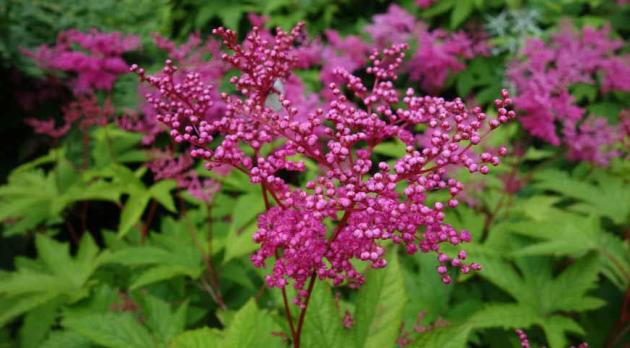
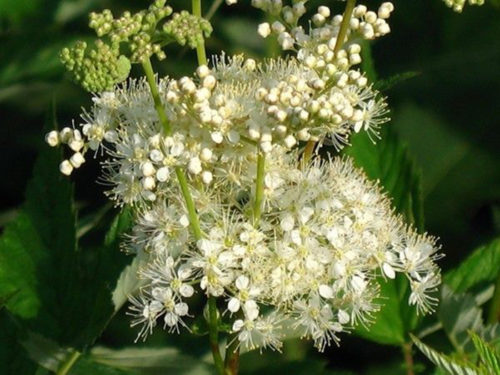
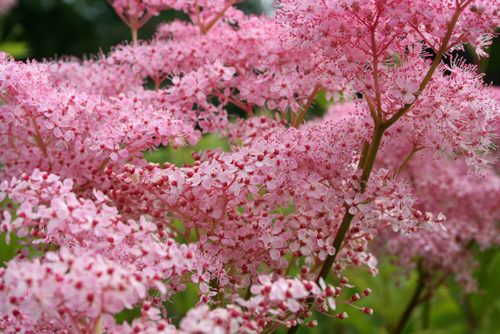
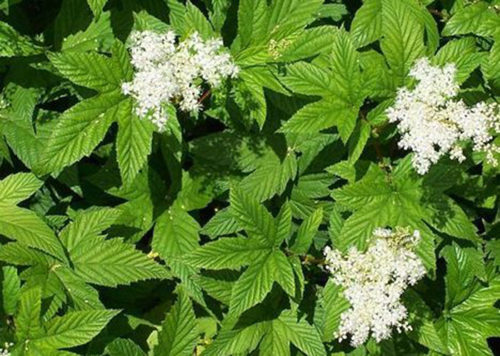
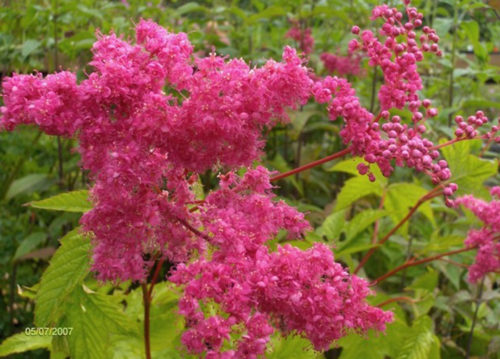

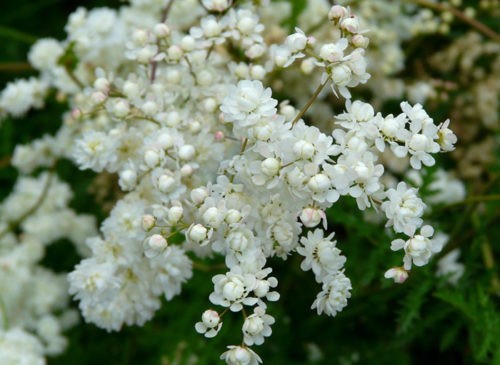
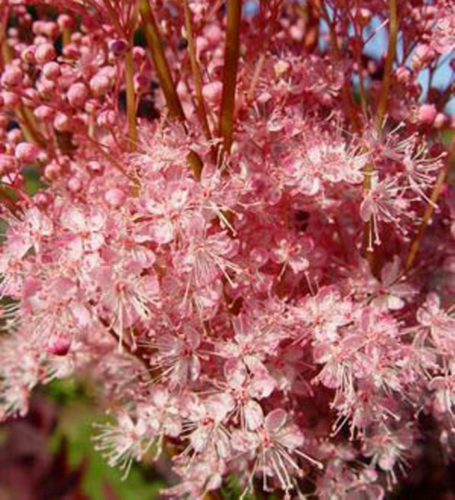
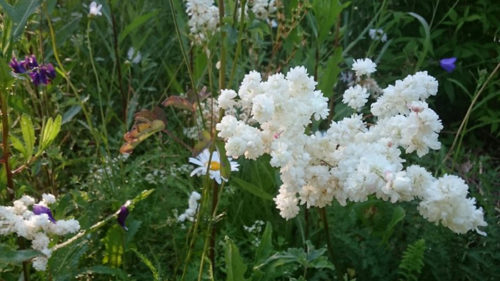

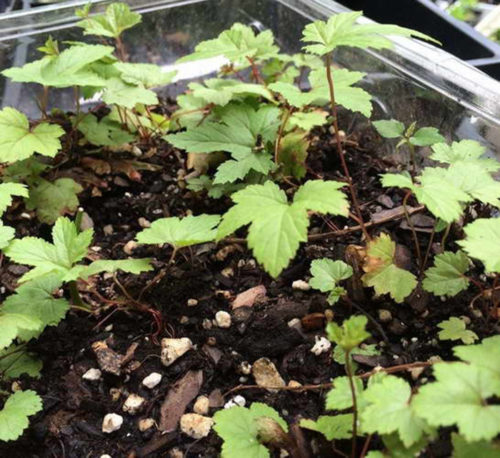


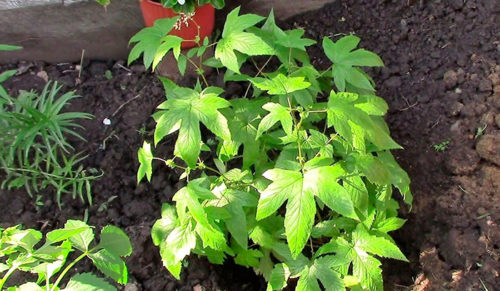
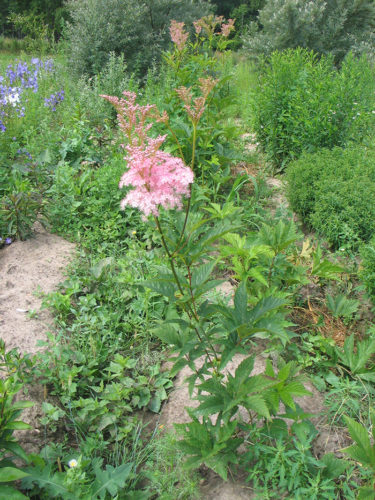
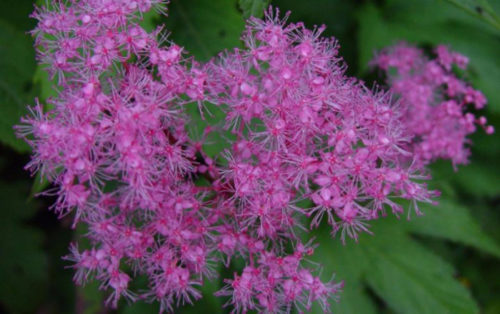
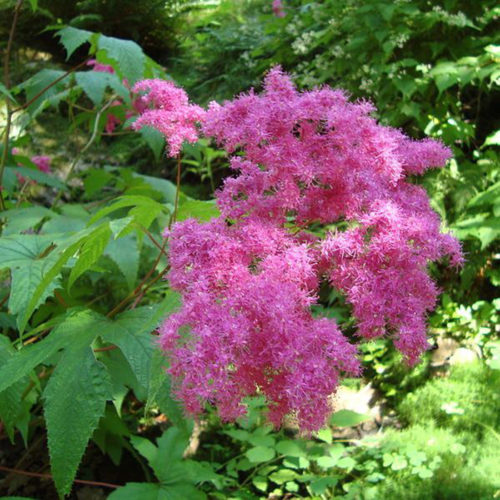

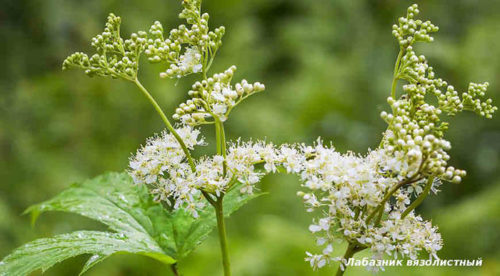
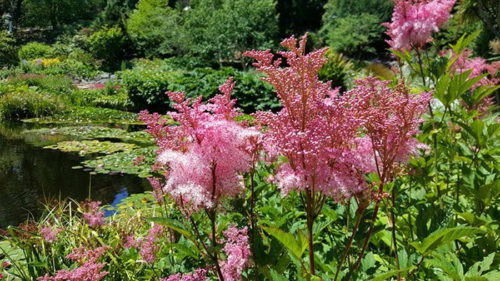












 Start a discussion ...
Start a discussion ...